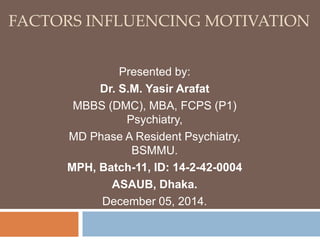
Theories of Motivation
- 1. FACTORS INFLUENCING MOTIVATION Presented by: Dr. S.M. Yasir Arafat MBBS (DMC), MBA, FCPS (P1) Psychiatry, MD Phase A Resident Psychiatry, BSMMU. MPH, Batch-11, ID: 14-2-42-0004 ASAUB, Dhaka. December 05, 2014.
- 2. Motivation The set of forces that cause people to behave in certain ways
- 3. Motivation Factors that direct and energize behavior of humans and other organisms Motives - particular desired goals that underlie behavior Exemplified in behavior Steer one’s choice of activities Forces that direct future behavior
- 4. Conceptual Approaches Instinct Drive-reduction Arousal approaches Incentive approach Cognitive approach
- 5. Instinct approach Inborn pattern of behavior Biologically determined not learned Born with preprogrammed set of behavior essential for survival Provide energy that channels behavior in appropriate directions
- 7. Drawbacks No agreement on nature & number of primary instinct 18 instinct (McDougall, 1908) 5,759 instinct (Bernard, 1924) Can’t explain development of specific behavior pattern of a given species However focus on evolution and genetic inheritance
- 8. Drive-reduction approaches Hull, 1943 Lack of some basic biological requirement produce a drive to obtain that requirement Drive- a motivational tension or arousal that energizes behavior to fulfill some need Primary drives: related to biological needs of body or species as a whole; hunger, thirst, sleepiness, sex Secondary drives: created by prior experience and learning: achievement, affiliation, power
- 10. Homeostasis Try to satisfy primary drive by reducing the need underlying it Body has a tendency to maintain a steady internal state Operates through feedback loops bring deviations in body function back to an optimal state
- 12. Drawbacks Inadequate to explain behavior to maintain or even increase level of excitement or arousal Curiosity and thrill seeking behavior
- 13. Arousal Approaches Try to maintain a certain level of stimulation and activity Increasing or reducing them as necessary
- 15. Incentive approaches Based on Operant Conditioning Theory Stem from the desire to obtain valued external goals or incentives Desirable properties of external stimuli account for a person’s motivation Act as an anticipated reward or incentive Punishment
- 17. Drawbacks Not a complete explanation of motivation seek to fulfill needs even when incentives are not apparent Internal drives proposed by drive-reduction theory work in tandem with the external incentives theory to “push” and “pull” behavior
- 18. Cognitive approaches Product of people’s thoughts and expectations – their cognition Intrinsic motivation: participate for our own enjoyment Extrinsic motivation: for any concrete, tangible reward
- 19. Maslow’s Hierarchy of Motivation Motivation progresses up the pyramid from the broadest, most fundamental biological need to higher order ones. Certain primary, lower order needs, at the bottom level, must be satisfied before more sophisticated, higher, order needs, in order to work effectively.
- 20. Lower and higher order need Basic physiological need Safety & security Then, need for love and belongingness Strive for esteem, to develop a sense of self-worth by knowing that other know and value one’s competence, comes next. Highest-level need, self-actualization – a state of self fulfillment.
- 21. Hierarchy of Needs Need Level Description Examples Self- Actualization Realize one’s full potential Use abilities to the fullest Esteem Feel good about oneself Promotions & recognition Belongingness Social interaction, love Interpersonal relations, parties Safety Security, stability Job security, health insurance Physiological Food, water, shelter Basic pay level to buy items
- 23. Drawbacks Unable to validate the specific ordering Difficult to measure self-actualization Important: Highlights the complexity of human needs Emphasizes that until more basic biological needs are met, people will be unconcerned with higher order needs.
- 24. Secondary Drive Need for achievement: striving for success Astable, learned characteristic in which a person obtains satisfaction by striving for and attaining a level of excellence.
- 25. People with high achievement need Seek out situation to compete with standard to prove success Tend to avoid situation where success is easy or unlikely Take task of intermediate difficulty Produce positive outcome in success oriented society Indicates future economic and occupational success
- 26. Personality & Motivation Internal Locus of Control External Locus of Control Type-A personality Type-B personality
- 27. Need for Affiliation Striving for friendship Interest in establishing and maintaining relationships with other people. People with higher affiliation need: Emphasize desire to maintain or reinstate friendships Show concern over being rejected by friends Sensitive to relationships with others More time with friends- gender difference
- 29. Need for Power Striving for impact on others Atendency to seek impact, control, or influence over others, To be seen as a powerful individual People with strong need for power: Apt to belong to organizations and seek office Work in professions that fulfill power need Gender differences exist
- 30. References 1. Kaplan & Sadock's Synopsis of Psychiatry: Behavioral Sciences, 10th Edition 2. Psychology, 6th Edition- Andrew B. Crider 3. Understanding Psychology, 10th Edition- Feldman 4. Principles of Marketing, 11th Edition- Kotler
